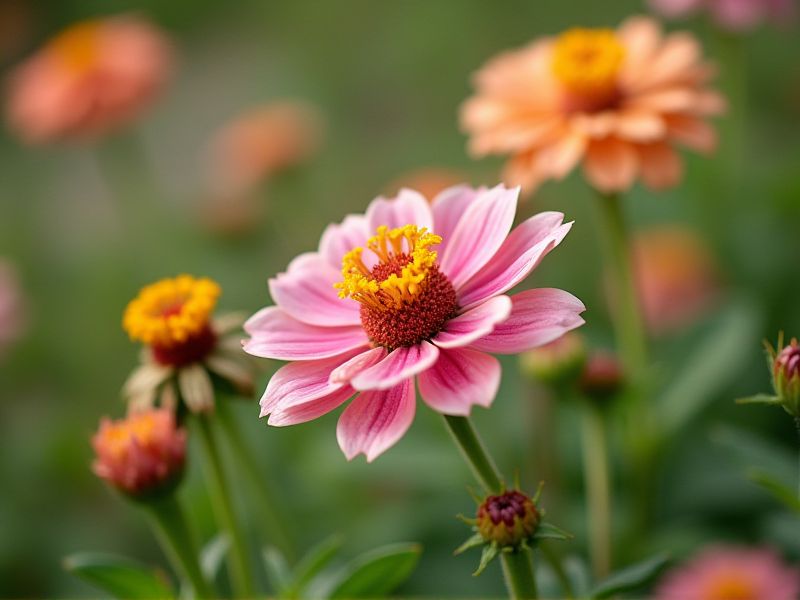
Several flowering plants require minimal pruning to maintain their beauty and health. The hardy Lavender (Lavandula) thrives without extensive trimming and offers vibrant blooms alongside aromatic foliage. Similarly, the Butterfly Bush (Buddleja) can be easily shaped with a light pruning in early spring to encourage abundant flowers. Coneflowers (Echinacea) are resilient perennials that not only need sporadic deadheading but also attract pollinators, enriching your garden's ecosystem. By choosing these low-maintenance options, you can enjoy a stunning yard with minimal effort in pruning and upkeep.
List of some Flowering plants that need little pruning
- Lavender (Lavandula)
- Coneflower (Echinacea)
- Butterfly Bush (Buddleja)
- Daylily (Hemerocallis)
- Russian Sage (Perovskia atriplicifolia)
- Yarrow (Achillea)
- Coreopsis (Coreopsis)
- Black-Eyed Susan (Rudbeckia)
- Catmint (Nepeta)
- Sedum (Sedum)
Important things about Flowering plants that need little pruning
Low-Maintenance Varieties
Several low-maintenance flowering plants flourish with minimal pruning, making them ideal for busy gardeners. For example, Echinacea (Coneflower) thrives in various soil types and requires very little care, blooming profusely throughout summer. Another excellent choice is the perennial lavender, which not only adds a delightful fragrance to your garden but also attracts pollinators while needing only occasional trimming. Opting for these resilient varieties ensures that your garden remains vibrant with minimal effort on your part.
Natural Growth Habits
Many flowering plants exhibit natural growth habits that require minimal pruning, making them ideal for low-maintenance gardens. Plants such as Hydrangeas, Butterfly Bushes, and certain varieties of Roses thrive with little intervention, showcasing their blooms and foliage beautifully without extensive cutting. These species not only enhance the aesthetic appeal of your garden but also support local ecosystems by attracting pollinators like bees and butterflies. By choosing these easy-care flowering plants, you can enjoy vibrant displays while spending less time on upkeep.
Drought Resistance
Many flowering plants exhibit remarkable drought resistance, making them ideal for low-maintenance gardens. Varieties such as the California poppy and lavender require minimal pruning while providing stunning blooms. These plants have adapted to arid environments, developing deep root systems and waxy leaves to conserve moisture. Incorporating drought-tolerant flowering plants into your landscape not only reduces water usage but also enhances biodiversity by attracting pollinators.
Disease Resistance
Flowering plants known for their exceptional disease resistance include varieties like the Knock Out Rose and the Butterfly Bush, which thrive with minimal pruning. These plants possess innate traits that deter common pathogens, making them ideal for low-maintenance gardens. Incorporating such resilient species into your landscape not only enhances visual appeal but also reduces the need for chemical treatments, promoting an environmentally friendly approach. Consider selecting disease-resistant flowering plants to enjoy a vibrant garden while minimizing labor and maintenance requirements.
Seasonal Blooming
Many flowering plants thrive with minimal pruning, making them perfect for gardeners seeking low-maintenance options. For instance, the popular hydrangea varieties, such as 'Annabelle' and 'Limelight,' produce stunning blooms without the necessity of extensive cutting back. Similarly, azaleas showcase vibrant colors in spring and typically require only light pruning to maintain their desired shape and health. If you prefer a vibrant garden with minimal upkeep, consider planting perennials like coneflowers and daisies, which naturally maintain their form and beauty while offering seasonal blooms year after year.
Pest Tolerance
Flowering plants such as lavender and hydrangea exhibit remarkable pest tolerance, making them ideal choices for low-maintenance gardens. These resilient plants often fend off common pests like aphids and spider mites through natural defenses, including aromatic oils and tough foliage. Minimal pruning is required to maintain their shape and promote healthy blooming, allowing you to enjoy vibrant flowers without the constant need for upkeep. By selecting these pest-tolerant flowering plants, you can cultivate a thriving garden with less effort and greater ecological resilience.
Soil Adaptability
Flowering plants such as lavender, daylilies, and coneflowers showcase impressive soil adaptability, thriving in a variety of soil types, including sandy, loamy, and clay soils. These resilient plants require minimal pruning, making them ideal for gardeners seeking low-maintenance options while still enjoying vibrant blooms. When planted in well-drained soil with adequate sunlight, these species not only flourish but also attract pollinators, enhancing your garden's ecosystem. Understanding the soil conditions and specific needs of these flowering plants can lead to a thriving, low-maintenance landscape filled with color and life.
Mulching Benefits
Mulching around flowering plants significantly improves moisture retention in the soil, ensuring your low-maintenance garden thrives even during drier periods. By suppressing weeds, mulch allows your flowering plants to receive essential nutrients without competition, ultimately promoting healthier blooms. Organic mulch, such as shredded bark or grass clippings, enhances soil quality as it breaks down, adding vital nutrients back into the ecosystem. With minimal pruning required for many hardy flowering species, incorporating mulch simplifies your gardening routine while enhancing the overall aesthetic of your landscape.
Minimal Nutrient Requirements
Flowering plants with minimal nutrient requirements often thrive in low-maintenance gardens, making them ideal for busy homeowners. Species like the North American coneflower (Echinacea purpurea) and lavender (Lavandula spp.) require well-drained soil and moderate watering, promoting resilience against pests and diseases. These plants typically flourish with minimal pruning, requiring only occasional deadheading to encourage new blooms and maintain shape. By selecting these hardy varieties, you can create a vibrant landscape that demands less effort while still offering beautiful floral displays.
Ecological Benefits
Flowering plants that require minimal pruning, such as native perennials and certain shrubs, contribute significantly to biodiversity by providing habitat and food for pollinators like bees and butterflies. These plants often require less maintenance and promote healthier ecosystems, allowing you to enjoy their beauty without the need for frequent intervention. By incorporating these low-maintenance options into your garden, you can enhance soil health and reduce water usage, as many flowering varieties are drought-resistant. Choosing flowering plants that thrive in your local climate not only supports ecological balance but also attracts beneficial wildlife to your outdoor space.
